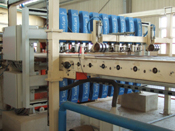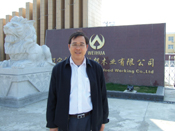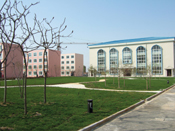New approach
17 June 2009The Weihua group has built a lot of continuous production lines in the last few years and one of its most recent is in Liaoning Province, as Mike Botting reports
As you will have read in the previous article (p24), the Weihua group has a total of nine production lines for fibreboard – three with multi-opening hot presses and six with continuous hot presses.
The fourth of the six continuous lines to be built by this rapidly-expanding group is located in Taian City in Liaoning Province.
The company is known as Liaoning Taian Weilibang Wood Working Co Ltd. Taian City is about 100km from Shenyang, the nearest airport for flights from Beijing, via very good quality expressway roads.
Most of Weihua’s mills are located in the southern half of China and this makes Taian its furthest north.
“We located here most importantly because the local government was trying to attract investment,explained general manager Liu Da Cheng, who had just taken over the post from Mr Liu Gong who had moved to managing Weihua’s Fengkai factory that day.
“Representatives of the local government here visited our Meizhou plant and offered incentives to build the factory here.
“Also, from a strategic point of view, we wanted to develop a market in northeastern China. The principle of the group was first to concentrate on the Guangdong market, then the more western area (Xiangfan, Hubei) of the market.
“Third came Beijing, Tianjing and Hebei and the fourth territory to be entered by the group is here in northeast China.
“This is our strategic territory plan and of course we also have to have a reliable wood raw material source for each factory.”
The wood for the Taian factory comes from a 300km radius and is purchased in the form of poplar logs to feed the Siempelkamp ContiRoll line which has a capacity of 220,000m3 a year. The company plans to develop a cooperation with partners who will provide ready-made chips in the future.
This is quite a large-capacity mill for China and Mr Liu explained that one reason is that it is the policy of Chinese customs that only plants of such size or above can be imported tax-free.
The groundwork for the Taian factory began in April 2007 and the first board was produced on December 8, 2008 with normal production commencing in January of this year.
The site was already an established industrial zone and is located very close to the major expressway – a big advantage for road transport, although there is also a large rail freight depot 25km from the factory. A couple of river ports are also within 100km of the Taian facility.
Shenyang is mainly famous for steel and petrochemical industries but also has a lot of factories making doors and flooring, said Mr Liu.
“Those door and flooring factories form our main market although we also sell some thin board at 2.8 to 3mm to other parts of China.
“So far we do not export and are still fine-tuning our production, but we hope to export in the future.”
Mr Liu is looking forward to the next development stage for his factory as he said Weihua is currently negotiating with a “very famous flooring companyto build a flooring production line at Taian as a joint venture utilising the flooring company’s established brand name.
“We would also welcome any foreign enterprises that would like to cooperate in a similar way, with flooring or door manufacturing lines,said Mr Liu.
The policy of the Weihua group is always to arrange sales centrally from head office in Guangdong. Each factory has its own sales department which works with head office and most plants have a speciality – Taian’s is thin board.
Out of the six continuous lines in the Weihua group, this is the first from Siempelkamp and Mr Liu feels it is good to have a different make of line for comparison. “Each make has its own advantages and disadvantages,as he put it.
At the time of my visit, the factory’s problem was not with the press itself but with the stainless steel endless belt, which had not been welded together correctly when first installed and was having to be re-welded due to some distortion of the seam.
Chipping was supplied by Pallmann of Germany. The refiner came from Andritz and is a 54in diameter unit. The glue kitchen and blending system came from Siempelkamp associate company Imal of Italy.
On-the-line quality control was supplied by SicoScan, a cooperation between Siempelkamp and Electronic Wood Systems (EWS) of Germany. Other recent Weihua plants also use this technology.
Siempelkamp supplied everything from the fibre selection to the end of the ContiRoll press, which is 23.8m long and eight feet wide.
There is an Anthon cut-to-size angular sawing system and a Steinemann six-head sander. The latter is being extended to eight heads and the additional two heads were in transit from Switzerland at the time of my visit to Taian in late April.
The energy system came from Chinese manufacturer Changzhou Union and is one of the largest in Asia, according to Mr Liu.
Like all other Weihua mills, Taian has the signature entrance representing trees on one side and wood based panels on the other, in bricks and mortar and tiles.
It also has three apartment blocks for its 200 on-site staff and a canteen building on two floors which includes facilities for the playing of ping pong (table tennis), badminton and so on.
Like all panel makers in China at the moment, Weihua Taian is not finding the market easy.
“I think that until next year we will have a very tough life – in fact probably until 2011 or later,said Mr Liu. “This was a difficult time to bring a new line on stream, but our policy is to produce better quality and more competitive panels for the market.
“Currently Weihua is only producing MDF and HDF but the company is thinking of diversifying into OSB, although plans have been delayed by the economic situation. I think there is a prosperous market future for OSB in China. People’s perception of the product is changing and I think there will be more OSB used in the production of some furniture such as cupboards and closets in houses where MDF is now used.
“I don’t think the group will build another MDF/HDF line like this one – if we wish to expand in MDF in the future I think it is more likely we will take over another producer than that we will buy another continuous line from Europe.”


